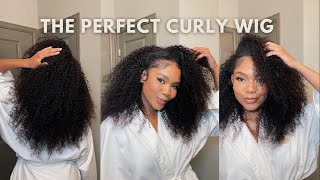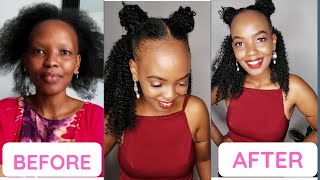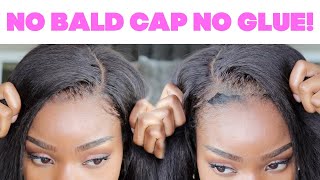Long Healthy Natural Hair Pyramid - A Regimen At A Glance
You can’t create a one size fits all approach to a natural hair regimen, even amongst natural hair gurus, their specific journeys and methods responsible for their successes are very divergent, sometimes even downright contradictory.
Rather than going down the route of an example natural hair regimen as I did before, I thought a visual of what constitutes a good regimen in this handy pyramid below would be better. Like with food pyramids, you should be able to see at a glance what your regimen should look like!

Click Image To Enlarge
Share the graphic on your website!
I have not included any co-washes in the pyramid as you see. Although co washes help with moisture in dry natural hair, the tendency to tangle certainly does not encourage good length retention in the long run. If you are a natural like Curly Nikki who enjoys keeping shoulder length curls then co-washes are a wonderful way to infuse some mid-week moisture. If however length is your long term goal, stick with a spray bottle and some shea butter* for your moisture needs in between washes!
Daily
• Moisturize and seal daily or at least every other day depending on your hair’s needs. Fine strands may want to go with light oils* like coconut oil but coarse strands should go with shea butter or other heavy oil.
• Drink water daily, this helps with optimal skin and hair health.
• If you have opted to include vitamins in your regimen take them daily for maximum effect.
• Style your hair with your fingers only but try and make your styles last all week without restyling!
• Green house effect (GHE) some people add this to their regimen daily to increase hair growth, remember though that as a natural GHE will encourage shrinkage and shrinkage is not a good friend of a hair grower.
• Accessorize daily to avoid getting bored with protective styling!
• Cover your hair nightly with a satin bonnet* or sleep on a satin pillowcase*.
Weekly
• Naturals are not as prone to hygral fatigue as relaxed hair but pre-pooing is a good practice anyway because it prevents excessively dry strands after your shampoo.
• Choose sulfate free shampoos to wash your hair wherever possible or skip the shampoo step all together.
• Deep condition with heat while alternating your protein and moisturizing deep treatments. Naturals who don’t color their hair will not need a great deal of protein.
• Steam treatments – These will soften very coarse strands better than any conditioner so invest in a good steamer* if you can afford to.
• Optimally you should include scalp massages into your regimen daily but if you are too busy at the very least give your scalp a good massage while you wash your hair every week.
• Naturally your wash day should be the only time that you use combs and brushes and even then very minimally. Detangle GENTLY from ends working your way up to the roots.
• Do your twist/braid outs on wet hair so that you can get maximum staying power from the style. This allows you to go all week without having to restyle your hair.
• Diffusers on a COOL setting can also be used weekly without any negative effects. These are especially useful in colder months when you don’t really want to be walking around with wet hair!
Monthly
• Protective styling is very important for natural hair growth. Try to keep your hair away for a least 3 weeks out of every month. If you are not into weaves* or wigs*, you can do this by twisting your hair and wearing the twists for two weeks before releasing them for a twist out on the third week. That way you are keeping your detangling sessions to just 1 a month!
• Do your hot oil or other treatments like the caramel treatment or henna.
• Naturals tend to be quite heavy handed with oils* and also tend to avoid shampoos in favor of co-washing so if you start noticing a flaky scalp you may want to clarify your hair at this point.
• Redo the perimetre and parting sections of braided or twisted styles monthly. You don’t have to redo your entire head of hair but taking down and re-braiding or re-twisting the perimetre sections allows your braided styles to look freshly done for the duration of the style.
6-8 Weeks
• Hard protein treatments for naturals are on a ‘needs must’ basis. Black hair in it’s stucture is inherently weaker than other hair types so it does tend to need a helping hand in the strength department. Some naturals may be able to maintain a good moisture protein balance just with alternating their conditioners weekly but others will find that they do better with an Aphogee every 8 weeks or so. If you have every lifted color from your hair with bleach or peroxide however, protein treatments are a must!
• For weave* wearers, I would strongly suggest that you take them down and re-do them monthly. This allows you to give your hair and scalp a good cleaning, get rid of shed hair and prevents matting which inevitably leads to more breakage when left unchecked.
• If it is too time consuming or expensive to re-do braided styles monthly don’t let them go over the 8 week mark because matting will almost certainly happen which could lead to a major setback.
12+ Weeks
• Hair color – If you regularly use hair colorants that contain peroxide or ammonia; for the same reason as with relaxers you will want to wait until you have a fair bit of hair growth before retouching them obviously to avoid double processing your hair and weakening it. Of course if you are using herbal colorants like henna*, you can touch up your roots monthly if you wish.
Occasionally
• Although I am pro-choice when it comes to how you want to wear your natural hair, and some natural ladies prefer to wear it straight, I am also well aware that it is counterproductive to give the green light on regular use of heated tools. If you are a veteran and you have conclusively demonstrated an ability to retain length while using heated tools regularly, then carry on! If things start to go a bit wrong in your regimen though, heat should be the first thing you should remove.
• A final word on heat, (and you are going to have to take my word on this ;)) you will find that as your hair grows longer, it will become harder and harder to go through the process of straightening your hair with any form of regularity. Eventually for the sake of saving time (and sanity) you will probably find that you want to use heat only a few times a year to check length or for a special occasion.
If you missed the long healthy relaxed hair pyramid, check it out here.




